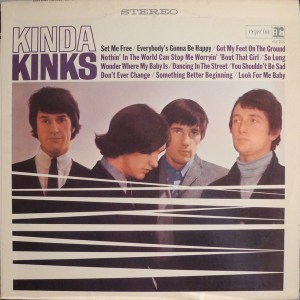More of the Music of The Kinks
Reviews and Commentaries for the Music of The Kinks

- Very good Hot Stamper sound on both sides of this original STEREO copy of The Kinks’ sophomore release
- You’ll find that there’s a healthy dose of the Tubey Magical Richness here, which is exactly what these recordings need in order to sound their best
- The monos win the shootouts, but the better original stereo pressings can sound quite good on their own terms
- “…this album showcased a much more sophisticated sound… it also put them right in the front of the British Invasion pack for seriousness and complexity, out in front of where the Beatles or almost any of the competition were in early 1965…”
What the best sides have to offer is not hard to hear:
- Bigger, more immediate staging in a large acoustic space
- More Tubey Magic, without which you have almost nothing. CDs give you clean and clear. Only the best vintage vinyl pressings offer the kind of Tubey Magic that was on the tapes in 1965
- Tight, note-like, rich, full-bodied bass, with the good weight down low
- Natural tonality in the midrange — with all the instruments having the correct timbre
- Transparency and resolution, critical to hearing into the three-dimensional space of the studio
No doubt there’s more but we hope that should do for now. Playing the record is of course the only way to hear all of the above.
Standard Operating Procedures
What are the criteria by which a record like this should be judged? Pretty much the ones we discuss in most of our Hot Stamper listings: energy, vocal presence, frequency extension (on both ends), transparency, harmonic textures (freedom from smear is key), rhythmic drive, tonal correctness, fullness, richness, and so on down through the list.
When we can get all, or most all, of the qualities above to come together on any given side we provisionally award it a grade of “contender.” Once we’ve been through all our copies on one side we then play the best of the best against each other and arrive at a winner for that side. Repeat the process for the other side and the shootout is officially over. All that’s left is to see how the sides matched up.
It may not be rocket science, but it is a science of a kind, one with strict protocols that we’ve developed over the course of many years to ensure the results we arrive at are as accurate as we can make them.
The result of all our work speaks for itself. We guarantee you have never heard this music sound better than it does on our Hot Stamper pressing — or your money back.
TRACK LISTING
Side One
Look For Me Baby
Got My Feet On The Ground
Nothin’ In The World Can Stop Me Worryin’ ‘Bout That Girl
Naggin’ Woman
Wonder Where My Baby Is Tonight
Tired Of Waiting For You
Side Two
Dancing In The Street
Don’t Ever Change
Come On Now
So Long
You Shouldn’t Be Sad
Something Better Beginning
AMG 4 1/2 Star Review
The Kinks’ second album, Kinda Kinks, was rush-recorded on either side (and in the midst) of a world tour that took them all the way to Australia in the course of bridging the 1964-1965 New Year.
Under those circumstances, the fact that every cut but one was an original was no small tribute to the songwriting ability of Ray Davies, even if most of the songs were less than first-rate — because what was first-rate was also highly memorable, and what wasn’t also wasn’t bad. In the space of two frantic late-December and mid-January sessions, and a brutal week in February of 1965, the group cut 11 songs to fill out a long-player that was already destined to contain “Tired of Waiting for You” (a product of the previous summer’s work, held back by producer Shel Talmy for a single).
Also along for the ride were the latter’s driving B-side “Come on Now” and “Something Better Beginning” (both cut in December 1964). So the resulting record was uneven but filled with promise, and possessed of at least three bright spots — additionally, and equally important, this album showcased a much more sophisticated sound, Dave Davies’ guitar turned down (and even switched to acoustic in a couple of spots) as Ray Daviesbegan exploring aspects of emotions and storytelling that transcended anything in the group’s prior output — “Nothin’ in This World Can Stop Me Worryin’ ‘Bout That Girl” may have been a mouthful of a title, but it also put them right in the front of the British Invasion pack for seriousness and complexity, out in front of where the Beatles or almost any of the competition were in early 1965, but it didn’t stop them from switching gears to the bluesy “Naggin’ Woman.”